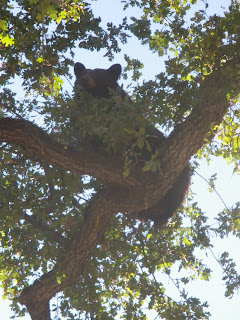It's a great time for photography in Yosemite. Though the sugar maple has gone bare, the big-leaf maples, dogwood and dogbane are really bright now, if you're in the right places. Oaks and cottonwoods are waiting their turn in the Valley. The Crane Flat and Hetch Hetchy areas are really colorful now.
-Photographers Keith Walklet and Mike Osborne still have a few spaces in their November 1-4 field program with Yosemite Conservancy. They are a remarkable team with a lot of Yosemite accomplishments to their credit.-Two dark bears were seen for several days eating acorns high in a valley oak by the railroad engine in El Portal. In Yosemite Valley, they've also been harvesting directly from the canopy. With bathing suit season over, the bears are trying to take in 20-30,000 calories/day so they'll have a comfortable winter's sleep.
-Winter birds have arrived: juncoes, white-crowned and golden-crowned sparrows have descended to find seeds in snow-free El Portal for the winter. Varied thrushes have been seen in the Valley and near Merced Grove already. Naturalist Dan W. reports a meadowlark in Ahwahnee Meadow from earlier this week, when he was leading a "Yosemite Insider Experience" group for the Conservancy.
-We had another mild storm come through Monday, closing Glacier Point and Tioga Road with a few inches of snow. They're both likely to re-open shortly. The precipitation finally initiated the river's seasonal rise, from the year's low of 18 up to 26 cfs. Normal would be in the low 30's.
-I had a chance to examine one of the hand-hewn wooden stakes that John Muir used 1872 for the first quantitative glacier study in the U.S. It was found by NPS personnel on the 1936 glacier survey and brought to the park's museum archive. It was pretty interesting to handle something that Muir himself made when he was up at our glaciers with Galen Clark and Joseph LeConte. Regretably, Muir didn't bring his digital camera on those two trips...
Friday, October 26, 2012
Friday, October 12, 2012
Insatiable albedo
It's autumn and in Yosemite Valley:
-days are shorter
-the cliffs and trees cast longer shadows
-the sun is at a lower angle so it lights less ground
But we also find that:
-the lower sun lights the north wall more directly
-the pale, dry grass gives off a brightness not seen in summer's dark green
-the yellow of maples, milkweed, dogbane, raspberry and some oaks and cottonwoods add increased reflectivity to the substrate, from leaves both on plants and that have fallen on the dark ground.
This 'yellow day of October' bears out Muir's notion that the Sierra may actually be composed of light. It's nice to contemplate the conflation of matter and the electromagnetic spectrum while beholding the reflected glow with your own eyes here in Yosemite.
-In the Valley last week Conservancy naturalist MRoss observed both a gray catbird and the Asiatic form of an American Pipit.
-The one sugar maple in Old Yosemite Village is bright red-orange now.
-We are getting our first dusting of snow in the high country, with Tioga Pass being closed briefly.
-The Merced River flow at Pohono Bridge has flatlined at a thin 19 cfs. The historical average river volume for today is 30 cfs and rising.
-Geologist GStock's latest glacier observations indicate a rate of motion for the Maclure Glacier that is identical to what Muir measured 140 years ago. Sadly, though it's bigger than the Maclure, the Lyell Glacier appears to be in a terminal phase.
-That's Venus you see, really bright in the eastern sky in the morning. The nearby star is Regulus, the brightest star of Leo. What can we interpret from the apparent proximity of the goddess of love and the king of the beasts? Only our own spatial provincialism; Regulus is not close but is 77 light-years away from Venus. Regardless, the light of both bodies adds to the shine of not just Yosemite, but our whole bright world.
-days are shorter
-the cliffs and trees cast longer shadows
-the sun is at a lower angle so it lights less ground
But we also find that:
-the lower sun lights the north wall more directly
-the pale, dry grass gives off a brightness not seen in summer's dark green
-the yellow of maples, milkweed, dogbane, raspberry and some oaks and cottonwoods add increased reflectivity to the substrate, from leaves both on plants and that have fallen on the dark ground.
This 'yellow day of October' bears out Muir's notion that the Sierra may actually be composed of light. It's nice to contemplate the conflation of matter and the electromagnetic spectrum while beholding the reflected glow with your own eyes here in Yosemite.
-In the Valley last week Conservancy naturalist MRoss observed both a gray catbird and the Asiatic form of an American Pipit.
-The one sugar maple in Old Yosemite Village is bright red-orange now.
-We are getting our first dusting of snow in the high country, with Tioga Pass being closed briefly.
-The Merced River flow at Pohono Bridge has flatlined at a thin 19 cfs. The historical average river volume for today is 30 cfs and rising.
-Geologist GStock's latest glacier observations indicate a rate of motion for the Maclure Glacier that is identical to what Muir measured 140 years ago. Sadly, though it's bigger than the Maclure, the Lyell Glacier appears to be in a terminal phase.
-That's Venus you see, really bright in the eastern sky in the morning. The nearby star is Regulus, the brightest star of Leo. What can we interpret from the apparent proximity of the goddess of love and the king of the beasts? Only our own spatial provincialism; Regulus is not close but is 77 light-years away from Venus. Regardless, the light of both bodies adds to the shine of not just Yosemite, but our whole bright world.
Subscribe to:
Posts (Atom)

